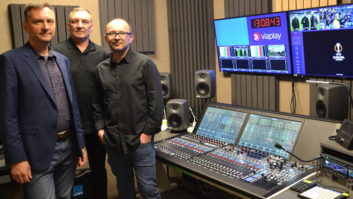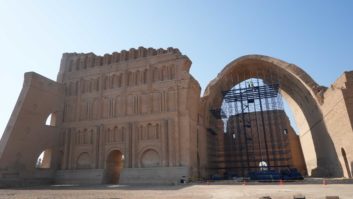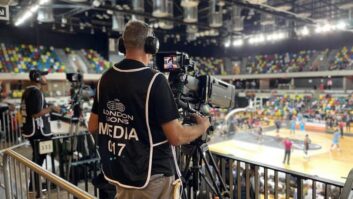Over the past three years the promise of 5G has gained momentum. This connectivity will not only supercharge the ability for industry to automate but also enable the delivery of the next level of digital transformation such as Augmented and Virtual Reality, robotics, real-time translation, training and E-health applications. But to realise it, there has to be enough spectrum available on the most suitable bands to support it.
In the largest broadcast engineering project since the digital switchover, Arqiva has now freed up spectrum for mobile operators to meet these rising mobile data demands. Initiated by Ofcom in 2014, the 700MHz clearance project involved moving around 54 per cent of digital terrestrial television (DTT) multiplexes from the 700MHz band to different frequencies.
Considering that 80 per cent of our DTT transmitter sites were affected by the 700MHz clearance programme, this was no small task. Changing the transmission frequency of the nation’s favourite channels at major transmitter sites across the country, including the BBC, ITV and Channel 4, had to be done with minimal disruption to viewers.
Fortunately, the meticulous planning process meant that this was achieved without causing any signal disruption to 17.8 million Freeview households who were required to retune.
Frequency planning
Ofcom’s consultation period began in May 2014, and the final decision was made in November of that year. Consultation concluded that using the band for mobile services will result in significant benefits to citizens and consumers with better and cheaper mobile broadband services. Once it was confirmed that the clearance was going ahead, we worked closely with all stakeholders to develop a new frequency plan. For the 700MHz clearance programme, the various parties included Ofcom, Arqiva, television and radio broadcasters, plus a number of delivery partners responsible for completing technical works on site including antenna replacement; transmitter retuning and all site preparation works including civils and power. Working with these industry players we created a transition roadmap identifying which services needed to be relocated to new frequencies to maintain coverage, while minimising interference between transmitter sites in an increasingly congested lower frequency band.
The challenge we faced was that in some parts of the UK, there are simply not enough frequencies available to support the number of transitions. This led to a whole number of new challenges for spectrum planners. To overcome this, Arqiva transmitted signals on the same frequency from adjacent stations to create a single frequency network; for this to be successful, we also had to introduce time synchronisation systems.
Rollout Planning
As well as a robust frequency plan, the smooth execution of the 700Mhz project depended on a strict order in which changes were made to avoid any impact on viewers. With the main station frequency plan finalised by 2016, we once again collaborated with our stakeholders to develop an agreed transition sequence which dictated the order in which frequencies were to be changed. Once a stable sequence for the planned frequency changes was determined, this was used as the underlying plan against which all design and implementation activities took place.
Comprising 57 retune events, each affecting multiple main stations and relays, this plan kicked off in 2017 and was finalised in August 2020. As well as taking a staggered approach, each step has also had to fit around protected events such as the June 2017 General Election, plus the May 2018 royal wedding and the FIFA Football World Cup 2018 – must-see broadcast events that absolutely can’t be interrupted.
Implementing the plan
Our 80 main station antennas are designed to transmit at a certain set of frequencies. These 80 sites are typically house masts or towers up to 300 metres in height that deliver Freeview to around 90 per cent of the total UK population – as well as national radio services.
We put together a detailed design of the antennas on their new frequencies, in order to determine an acceptable retuning pattern. If the pattern wasn’t workable for a specific antenna, we would then modify it or replace the whole thing so it could transmit its existing channels and the post-clearance channels.
To avoid impacting viewers, we started this work early: the design process began in 2015, with the first actual changes taking place in the first quarter of 2016. Every job was slightly different – some antennas took a year to fully build, while others needed just a week of adjustments.
Having made sure that our main station antennas could operate on the new frequencies, the actual returning process could then take place. Through the deployment of temporary transmitter systems, we were able to retune main stations with relatively short overnight outages. In total, Arqiva’s team dedicated 1.2 million hours of manpower to switching 465 antennas and relays without causing disruption.
Conclusion
The management and execution of the 700MHz spectrum clearance programme was one of the most complex projects that Arqiva has ever undertaken, described by our programme director as “like performing open heart surgery on live TV services”. Using our extensive experience in spectrum planning and the design and implementation of world class broadcast transmission networks, we were able to complete the project 16 months ahead of schedule – despite disruption caused by the Covid pandemic, which meant the final Clearance Events were delayed from April 2020 to August 2020 due to the lockdown and then the development of safe working practices in accordance with government guidelines.
The end result means Ofcom is finally able to auction off spectrum that will usher in the new era of 5G.







